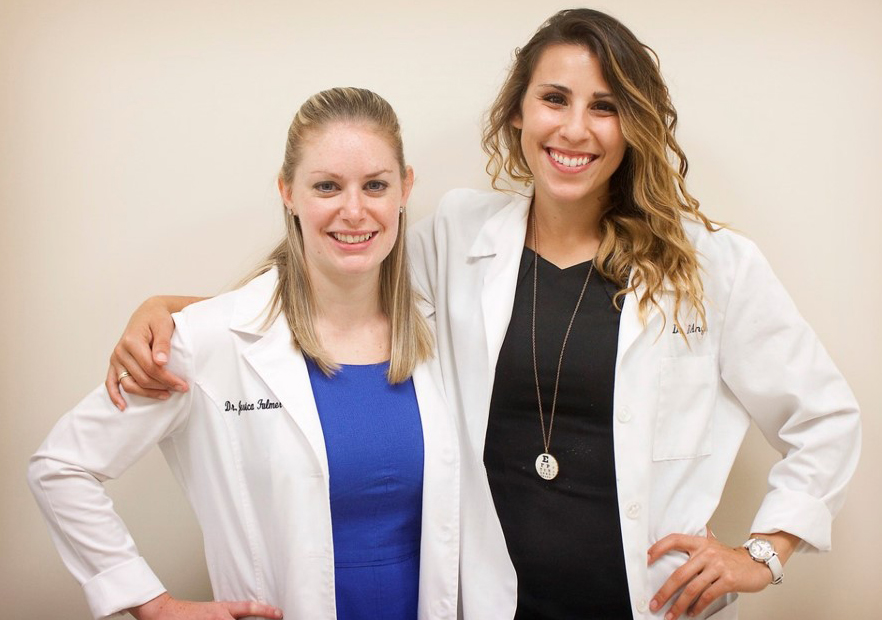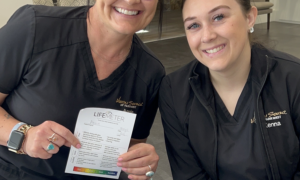
Staff members of Drs. Licausi’s and Zilnicki’s practice. Processes that ensure consistency have improve care and made the operations of the office more efficient.
By Miki Lyn Zilnicki, OD, FCOVD,
and Jessica Licausi, OD, FAAO, FCOVD
June 22, 2022
Consistent office processes can improve the care your patients receive, and the experience they have in your office while enhancing practice efficiency. For those reasons, we try in our office to enforce consistency in all we do. Here is the approach we take to accomplish this in our vision therapy-focused practice.
What Does “Consistency” Mean in the Patient Experience?
Consistency in patient experience to us means that every patient who calls or comes into our office receives the same experience and customer service, regardless of who they interact with in the office. This ensures that every patient receives identical information.
For example, we believe consistency starts from the first point of contact, which is most often with a phone call. Everyone in the office answers the phone exactly the same way: “Hello, thank you for calling Twin Forks Optometry and Vision Therapy, how can we help you?” Our team has worked hard to know exactly how to answer the most common questions that are fielded for a new patient calling. They go through this series of questions to schedule them appropriately.
This protocol starts off the patient relationship with clear, concise communication and sets the stage for success. We found that having a written protocol for patient communication helps ensure everyone follows the same script, which is especially important in our relatively small office where every employee helps with phones as needed.
Specific Actions You Can Take to Ensure a Consistent Patient Experience
Here are additional specific actions we take to ensure a consistent patient experience:
1. Send paperwork electronically prior to patient appointments, and, depending on the type of appointment, schedule a telemedicine appointment to discuss case history. This gives us the opportunity to spend more time with the patient doing testing and discussion of findings when they are in-office. Paperwork can be time consuming. Giving patients the opportunity to have it completed prior to coming into the office saves both us and them significant time.
2. We instruct the patient to check in from their car. We then call them in when they are ready to be seen. This is a spillover from our original COVID-19 protocol, but we are sticking with this new routine because it keeps the noise level and clutter down in our reception area.
3. All of our staff is cross-trained, but we each have a specific role we play. The team is orchestrated so that tasks are passed off to one another in a way that ensures the best patient experience.
4. We stay on time. We schedule our patients appropriately with sufficient time for their appointments to make it more likely that we run on time with no backlog of patients. We know no one enjoys long waits in a doctor’s office. Obviously, there are emergencies and patients who take longer than expected, but this is one part of the experience in the office that we strive to keep consistent.
Other Articles to Explore
What Does “Consistency” in Patient Care Mean?
Consistency in patient care means that every patient receives the same level of care from any provider they see in our office. We currently both see patients in the office, and have a maternity leave fill-in doctor who sees patients one day a week. In addition, we have two vision therapists who work directly with patients.
From a doctor perspective, we make sure that we tailor our examinations similarly between the two of us. Whether a patient is coming in for a primary care examination or a vision therapy evaluation, our work-up follows the same format and testing. We also established a model of follow-up care that is consistent between the two of us, particularly for our vision therapy patients.
We habitually recommend a trial of 12 sessions of vision therapy with a re-evaluation. We then make a final determination of total sessions needed following their first re-evaluation. Then, we perform a final re-evaluation, dispense a home therapy maintenance program and monitor post-vision therapy in six-week, three-month and six-month increments.
Having this set schedule ensures we are both on the same page when it comes to our vision therapy patients and that they receive the same care regardless of who they see! We often joke to our patients that we are the same doctor, just one has blue eyes and blonde hair and the other has brown eyes and brown hair.
It is important to us that our patients see us as interchangeable so they feel confident and comfortable under our care. Having young children at home, and with the protocol we enacted during the pandemic, we are no longer in the office on the same days as each other. We want our patients to receive consistent care no matter which day they visit the office. This protocol became even more important when we brought in another doctor to help with our maternity leaves. We felt confident in our fill-in doctor’s ability to jump right into seeing our patients and managing them the way we would.
Click HERE to see the vision therapy checklist we use in our practice to ensure consistency of care.
Document Your Newly Created Consistent Processes
We see ourselves as the driving force and beginning step of where consistency starts. For that reason, we sat down together to come up with our guidelines. This guaranteed that the two of us started off on the same page and with a consensus of how we envisioned our office systems running.
We created these systems in our office after discussing what we wanted our office experience to look like. Our advice is to work backwards. Write out how you want things to look/flow in your office and then figure out how to create that experience. Creating consistency takes time to set up initially, but once you have your systems implemented and staff trained, it allows for a smooth, efficient patient experience!
 Miki Lyn Zilnicki, OD, FCOVD, and Jessica
Miki Lyn Zilnicki, OD, FCOVD, and Jessica
Licausi, OD, FAAO, FCOVD, are co-owners of Twin Forks Optometry and Vision Therapy in Riverhead, NY.
To contact Dr. Zilnicki: DrZilnicki@twinforksoptometry.com.
To contact Dr. Licausi: DrLicausi@twinforksoptometry.com



























